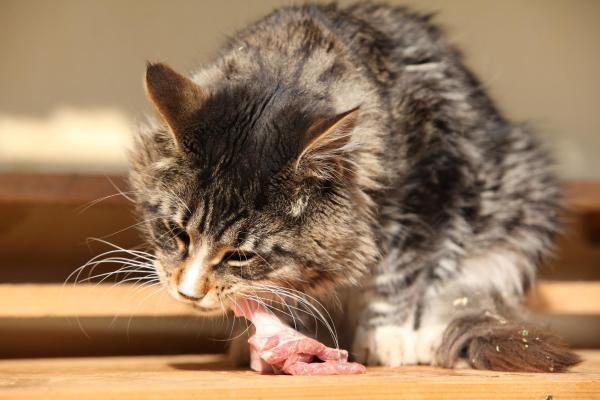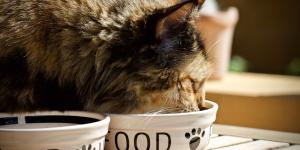Raw Food Diet for Cats



See files for Cats
Raw food diets are nothing new, but they have had a resurgence in recent years as we humans try to find the best way to lead a long and healthy life. The idea is that nutrients and benefits of raw food are removed from cooking. If eating raw food is a way we can boost the nutrition profiles of what we eat, many people have thought to use the same rationale for domestic cats. However, how rational is this rationale? At AnimalWised, we will discuss the pros and cons of providing a raw food diet for cats (BARF). This way, you can consider if this is might be a good regimen for your pet. We'll also report the considerations you'll need to make if you do want to implement a raw food diet for your cat.
Origins of the BARF raw food diet for cats
For English speakers, linking the word BARF with food can be quite off-putting. However, this acronym actually has two meanings: Biologically Appropriate Raw Food and Bones and Raw Food. It stemmed from a book published in 1993 called 'Give Your Dog a Bone' by Dr. Ian Billinghurst[1], although the terminology of BARF seems to have come later.
Billinghurst's fundamental idea behind BARF is that a raw food diet for domestic animals better represents the kind of diet their ancestors would have eaten in the wild. Their sharp canine teeth and incisors which exist to rip apart the tough flesh of raw meat are physical signs to support the idea that cats have not yet evolved away from eating raw food.
Another supposed impetus behind the raw food diet for cats is due to the deficiency of the commercial pet food. A lot of the companies which make commercial pet food boast about the nutritional benefits of their product, but the type of nutrition may not be ideal for kitties. This is because commercial pet food is often created with corn-based proteins which are difficult for cats to digest. Raw meat is thought to be better for providing the right protein for a cat's development and sustainability.
Commercial pet food also has to add certain nutrients, especially amino acids. Critics of the nutritional value of commercial pet food claim that cooking can remove these valuable nutrients even from pet food. Cats are known as obligate carnivores, meaning it is very difficult for them to survive without ingesting meat. This is despite some research which proposes vegetarian diets in companion animals[2].
Raw meat based diets for cats are argued to be the best way to provide the nutrition cats need to be at their healthiest. One particular factor is the importance of taurine in a cat's diet. This is a necessary amino acid which, if not ingested, will lead to hair loss and permanent blindness[3]. However, a raw meat diet has other factors which pet owners need to consider before administering to their cat.
Pros and cons of the BARF diet
Pros of raw food diet in cats:
- Eyesight: if taurine is found more abundantly in raw meat, then it could help fight against the debilitating diseases which can come from not having enough of it. Cats need this amino acid to fight against eye problems. Taurine can lead to something called central retinal degeneration (CRD) which can eventuate in complete blindness in your cat.
- Prevents heart failure: taurine is also essential in protecting your kitty's heart health. This is because it prevents the heart from enlarging and being unable to properly pump blood through the body.
- Lack of grains: there is a reason cats jump after mice and not corn cobs, grains are not a natural food for cats. Despite this, much of the commercially produced cat food contains grain such as corn. Cats cannot digest this as easily as meat, meaning raw meat and bones should better aid their digestion.
- Teeth: much of the commercially produced dry cat food is very crunchy. This isn't because your moggy doesn't like soggy food (although many do), but because the crunch helps the cat keep their teeth healthy. Bones, however, are even better for this and have been used by animals forever to get the same result.
- Appearance: fatty acids found in raw food will help keep your cat's fur silky and smooth as well as giving them a healthy deameanor.
- Energy: some cats don't need any more energy. They can dart around the place at whip speed, especially if they have yet to be neutered. However, cat's need energy to exercise and stay healthy. The abundant protein in raw meat will help expel and reserve energy for this purpose.
Cons of raw food diet in cats:
- Disease: while eating raw meat and bones is designed to ensure your cat is as healthy as possible, the biggest worry of a raw food diet is contracting an infection. Cats can eat animal carcasses that have been left out in the wild for a day and not become ill. However, the risk of eating raw food of contracting an infectious disease is significant. In studies on bacterial presence in raw food for pets, 50% had the presence of E. coli and 80% of raw chicken had salmonella present[4]. This is not only a danger to cats, but as this infections can be asymptomatic (i.e. not exhibiting symptoms), they can be transferred to humans without even realizing it.
- Parasites: if not looked after properly, raw meat can become infected with parasites which pass on to cat and can reside in their gut.
- Hassle: many people treat their pets as a full member of the family, so this is not a problem for them. However, if feeding raw food and bones to your cat, you need to ensure handling raw meat is as safe for your cat as it would be for a human. This means refrigerating food, clean surfaces, making sure food is thrown away after a certain time, etc. It can be very time consuming.
- Expense: many people become part time vegetarian because eating meat is expensive. Providing a BARF diet for your cat can lead to your weekly food costs skyrocketing.
- Nutrition: getting the right levels of nutrition on your BARF diet can be very difficult. Commercially produced cat food is often designed so that it provides the right balance for your cat. Getting the same balance at home takes a lot of trial and error as well as detailed knowledge about foodstuffs and feline nutrition. Getting it wrong can lead to deficiency in your cat and even ill health.
- Bones: you have to be very careful with the B in BARF. Bones can be serious choking hazards, even those which are large as splinters of bone can crack off and get stuck in the gullet.
- Convincing your cat: especially if your cat has already been on a different diet, introducing a new raw food diet for your cat can be very difficult. Many will simply refuse to eat it and starve themselves waiting for you to bring the food they expect. Also, you shouldn't put kittens on a raw food diet as they are both in need of a lot of nutrition as well as being more susceptible to infection.

How to feed your cat a raw food diet
If you have decided that you want to attempt a raw food diet with your cat, here are some guidelines to follow.
Between 60 to 80 percent of the food must be made up of raw meat, e.g. turkey necks, liver, chicken wings, etc. Only ten percent of this food should be from grated raw vegetables such as carrots, zucchini, celery, broccoli or even some fruits. We have detailed the fruits and vegetables cats can eat in another article.
Between 15 and 20 percent also needs to be from red meat such as lamb, duck or beef at least a couple of times a week. At least once a week offal (kidneys, liver, etc.) needs to be added to the food. Your cat can eat eggs, but only in moderation. Dietary supplements may also need to be added to your cat's raw food diet if you are concerned about there not being enough nutrition. This is one of the reasons you should always consult your veterinarian about whether or not you should feed a particular cat raw food. While many will be for or against, a good veterinarian will have done their research to best advise.
If you mix all of the ingredients together, you can chill it in the fridge and give your cat two servings per day. However, if your cat does not eat their serving in one go, you shouldn't leave the raw food sitting out. Either refrigerate it again or throw away. This can lead to wastage and also interrupt your cat's natural rhythms and eating habits.

An example BARF meal for your cat
If you are interested in starting a raw food diet for your cat, then here is an example to get you started:
- 1 pound of boneless chicken or turkey meat (breast, wings, etc.)
- 1.5 pounds offal (heart, liver, lungs, etc.)
- 2/3 pound grated vegetables
- 1 egg
- 1 tbsp fish oil
Preparation of BARF dish:
Either doing it yourself or asking your butcher to do it for you, remove all the meat from the bones. Grated the vegetables with a hand grater or in a processor. Mix the meat and vegetables together as well as possible and then stir in the fish oil. Cod liver oil is particularly good for cats. Add any additional supplements you may think will benefit your cat. This is something you should discuss with your vet. As similar as this may sound to human food, never add any seasoning to your cat's food.
It is up to you and your vet whether or not you should put your cat on a raw food BARF diet. However, it is a difficult process which may not always benefit your cat. While not all commercially produced cat food will be beneficial to your pet, a good quality one should have all of its nutrition needs covered. Besides, many cats have proven to have lived long happy and healthy lives without eating a raw food diet.
Also, as much research as has been carried out, it's not always easy to know what is the best food for your cat. Creme Puff was a domestic cat who lived to be 38 years old. His owner fed her a diet including bacon, eggs, asparagus and even coffee with heavy cream[5] (despite many sources claiming coffee and dairy products to not be good for cat's well being).
If you want to read similar articles to Raw Food Diet for Cats, we recommend you visit our Homemade diets category.








